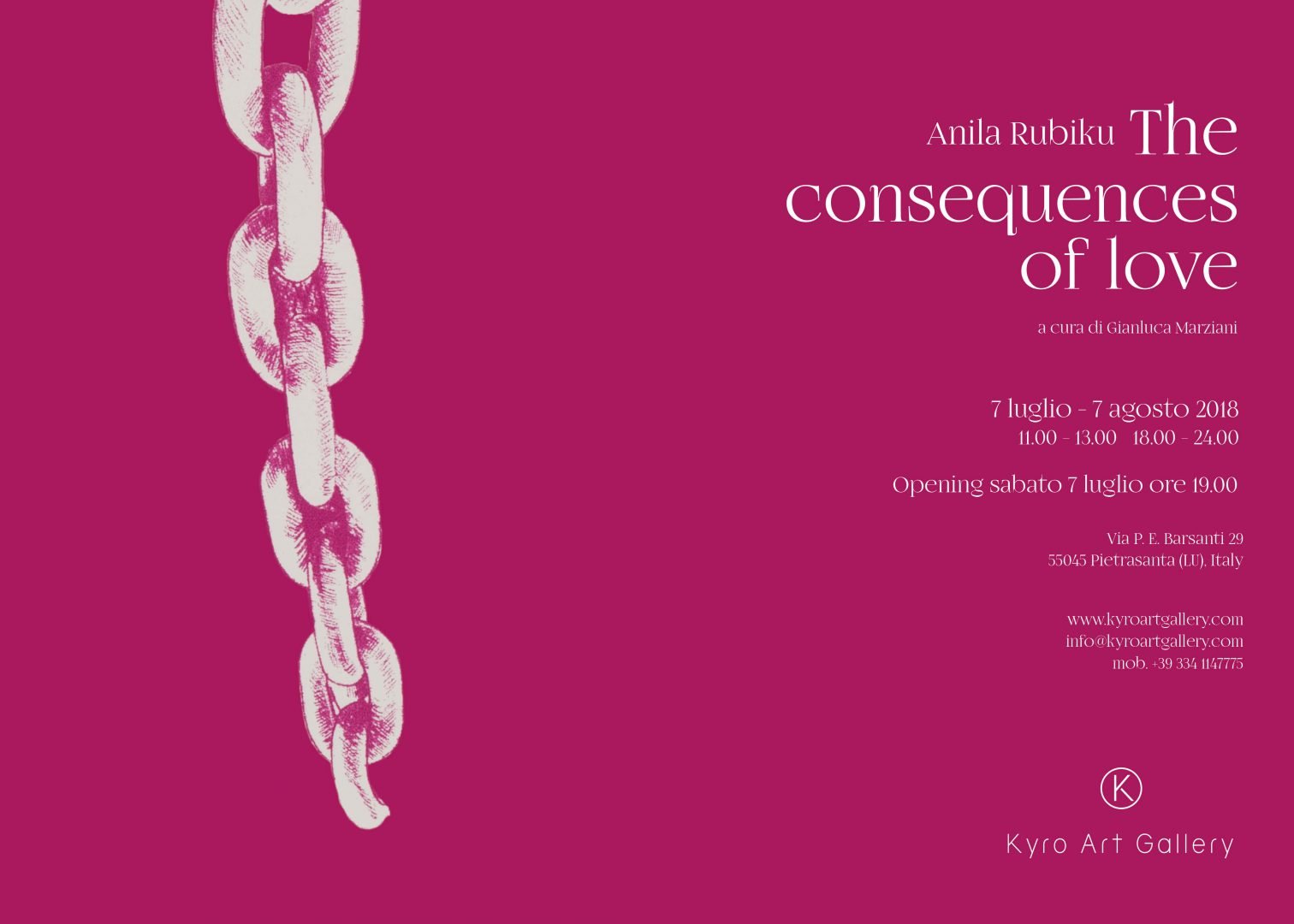
KYRO ART GALLERY presents a solo exhibition by the Albanian artist ANILA RUBIKU, opening Saturday 7th July at 7.00 pm. The project, entitled The Consequences of Love, is curated by Gianluca Marziani, director of Palazzo Collicola Visual Arts in Spoleto.
Chain n. [Lat. catēna]. – 1. a. Means of connection and union made of several rings of iron or other metal passed one inside the other, which serves to keep things, animals or people tightly bound, to suspend heavy objects, or for other uses…
The whole project revolves around the theme of the chain, presented in figurative variables that orchestrate the content that resides behind a word with multiple meanings. On the walls we find watercolour and screen-printed works on paper, two methods that tattoo cellulose with tactile density and metaphysical aura. A chain creates a strong symbolic value, a sort of open paradigm that through its path, joins some sentences taken from songs in which the emotional theme of the chain is apparent. To conclude the explanation of the preparation, there will also be some marble sculptures to widen the view on the plastic plane, offering physical theatricality to the artist’s project.
Gianluca Marziani writes in the catalogue: “I’m interested in the first sentence in the Treccani vocabulary: it speaks of ‘connection’ and ‘union’, two words that expose a healthy neutrality, an approach without the constraint that usually comes to mind when we talk about chains. Our language is molded in the spirit of our time, giving an unstable weight and volume to words, sometimes changing the air and aura. Events shape the habits of lexical terms, they create appearances that adhere to a certain social conscience. This is why Rubiku’s visual overturning works, the opening of meaning that does not impose the partiality of constraint but leaves room for vital connections, for unions that transmit energy, memory and culture…”
Some chains recall nature, others an intangible atmosphere, still others appear to be intestines, corpulent tissue, adipose flesh or pulsing muscle. The hard metal turns into an object that exists somewhere between David Cronenberg and Shinya Tsukamoto, alloys recapture their mineral nature and the object grows in the dimension of the subject. Metaphor and allegory intertwine ideals inside the white noise of Anila Rubiku’s metaphysical chains. Macroworld and microcosm traverse the archetype of the chain, animals and plants can be found, hidden but conceivable, they tease our interpretations, add sentences of impact that multiply the openings of meaning… until each ring is transformed into a single individual, a story to tell, a world to discover, a path to follow: in the name of the conquest, of the secular revelation, of the light that indicates, of the love that guides the reparation of the living.
There has always been an ideal sound that goes through a work, a flow that molds melody and rhythm according to the project, its iconic approach and the conceptual nature that that work expresses. Anila’s chains carry music in their DNA, recalling songs of multiple extractions, always concerning the broad theme of the “chain” as a sentimental metaphor, a pick of the pains and joys that love brings. The chain has always been a theme that fascinates songwriting and pop in general, spreading through the various genres of rock and indie culture. “Chains” immediately recalls some historical hits, there are verses and refrains that have followed the trends of our adolescence, our past holidays, our lived stories. But the chains are also in lyrics, in the themes of Classical music and Jazz, wherever there is a link between the pentagram and real life.
Anila Rubiku acts on the multiplication of a module / idea to determine a proliferation of meaning, an insistence to recreate narration through the variables of the matrix, until the short circuit that opens the synopsis to the ethical complexity of the message. A complex route in which the module creates homogeneity for the overall path, finding the links of connection between one cycle and another, a seam that translates the individual works into chapters of the same novel. Everything seems well conceived, well designed and well made; the works somatize the density of the “political” theme but never abandon the aesthetic vein, the refinement, the lightness of a methodical and harmonious execution. The formal device acts as an ethical detonator that leads to knowledge and then to reflection, according to sensitive codes which are the living grammar of the artist. The syntax of the work is what brings information towards textual analysis: at that point the user will establish his own reflection, pushing the plot to where the news does not usually arrive but where the inner eye travels deeply.

